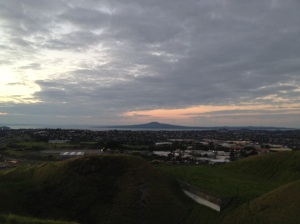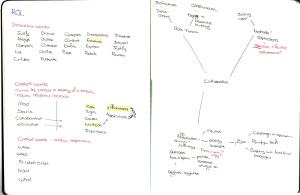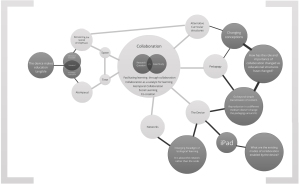As I go about my daily life, I almost inherently keep finding ways in which the simplest tasks and activities relate to my research.
Technology has played an increasingly prominent role in my life. Even these words I am typing on my iPhone as I go for a walk as the sun sets on the last day of midsemester break. I feel our engagement with technology makes us increasingly more aware of the passage of time. More often we comment on the perception that time is ‘speeding up’. Perhaps it is the atemporal nature of the virtual world that squashes together the past, present and future into one ‘space’ that bears little resemblence to any fixed embodiments of these concepts.
Take for example the next two images. It is evident that the two photos were taken at the same place but that time has elapsed between the two captures. A logical assumption would be that one was taken in the morning and one was taken in the evening. An analysis of the metadata would indicate that this is true, but in fact they were also taken about two weeks apart.
The passage of time is indicated in the weather / light conditions that occurred in the physical world, also in the constructed virtual representation embedded into the digital file. For me. the two images represent the morning of the first day of the two week break and the evening of the last day of the break.What isn’t conveyed by the images is the experiences that took place over the two weeks, they simply mark the beginning and end points. Time is compressed through the images, giving no real representation of the past / present. Emotionally, I can look at the images and reflect on the experiences that took place between the two captures.
I recently spent a weekend in an environment where there was no cellphone coverage. Without this connection, the devices suddenly had very limited functionality. As a digital native, this is always a daunting prospect but in reality, I realised that I was here to interact with all the people I normally would online. I didn’t miss having the Internet.
To delve a bit deeper – and relate this to my research – I actually spent a weekend over the break participating in a succession of six immersive scenarios. Each consisted of a prewritten setting and scenario and each participant contributed to it by being dressed appropriately for their predetermined character. Participants came from all over new Zealand to the shared physical space within which we all interacted to create a suspension of disbelief and immerse ourselves in a pretend world for three hours at a time.
So it sounds a bit crazy but it’s call live action role playing and it’s not all that different from playing an online game. I love the collaborative opportunity that arises from being able to network people in different cities to create these games, come together in a shared physical space and act it out. It’s escapism but it’s also an incredible opportunity to actually meet people, something that online gaming doesn’t necessarily offer.
As we came slowly back to grips with reality, and sat around reminiscing over the high points of the weekend, I found myself thinking how incredible it was that I was able to travel halfway down the country and immediately have a large group of people that I have a connection to, established and maintained predominantly through virtual mediums? Surely such a concept has only become prominent in recent years with the advent of the Internet / email / mobile devices / social networking. Yet, it was still a huge feeling of sadness as I had to fly back to Auckland. Something about putting that tangible physical distance between us again still has a profound emotional effect.
How does this relate to my research? Despite struggling through the process of writing a literature review, there were some very worthwhile ideas that came out of it. The article I found the most interesting was ‘A Theory of Learning for the Mobile Age’ (Sharples, Taylor, & Vavoula, 2007). The authors discuss the relationship between technological era and educational practice. We live in an era characterized by mobility of people and knowledge, a world of global digital communication. The basic function of the mobile device is to facilitate communication, communication shares understanding. Learning is a conversation and the mobile device enables more of these conversations to take place.
I’ve been dancing around the big question for a while of ‘what is learning?’ and I am going to come back to that in more detail. Specifically relating this article to the previously outlined experience: with ‘learning’ in a loose sense, I am gaining skills from LARPing that I perhaps I might not have otherwise. Different ways of engaging and interacting with people, making costumes and props, the historical settings and cultures that influence a game. Even by being connected with more people, it opens up the opportunity to learn from whatever life experiences and knowledge they have to share.
‘Knowledge’ is no longer locatable to the classroom, delivered by a teacher. Knowledge is imparted from people, places and experiences. As the device enables us to be more mobile, knowledge too is mobile. We learn across time and space, we apply the knowledge to the different contexts we find ourselves in.
“By placing mobility of learning as the object of analysis we may understand better how knowledge and skills can be transferred across contexts such as home and school, how learning can be managed across life transitions, and how new technologies can be designed to support a society in which people on the move increasingly try to cram learning into the gaps of daily life.” (Sharples, Taylor, & Vavoula, 2007).
There was a feeling of irony as I was writing my literature review, that I was making an argument of how the current technological era offers new ways to learn and engage with content while I was struggling through what I felt was a very unenjoyable experience of conforming to the rigid academic format of the literature review.
I feel it is important to reflect on every day experiences as part of the overall, ongoing learning experience. Mobile technologies enable me to express these thoughts and experiences as I try ‘cram’ more into the gaps of life where I’d otherwise be idly twiddling my thumbs.




